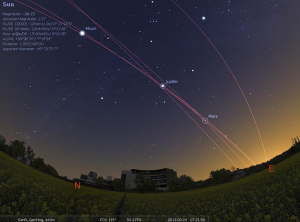Currently, no one knows why solar storms happen. Nor is it known in which direction or how fast the particles they produce move.
To solve these mysteries, students in Professor Gabriele Belle’s online section of ASTR 112 Introduction to Astronomy Lab have assisted professional scientists in a citizen science project called Solar Stormwatch. With the help of ASTR 112 students, and many other volunteers, scientists will be able to build a space weather forecast. A forecast of this nature can give astronauts an early warning if dangerous solar radiation is headed their way, can predict possible power outages caused by the highly active particles that are emitted from the storms, etc.
Watch this Solar Stormwatch video Solar Mysteries to learn more about the project.
Effective development of an online course necessitates much more than posting the previously crafted face-to-face course content online. It requires adaptation that fully integrates online resources. When properly integrated into course design, technology has the potential to create a more student-centered course, a greater degree of student independence, student controlled pace and learning pathways, and active student engagement with subject matter [1].
Professor Gabriele Belle, who has taught face-to-face Astronomy courses at Mason since 2009, believes that it is actually more effective to teach astronomy online than face-to-face. She explained that an online asynchronous course allows a student to work through each step of a process at their own pace and to be actively engaged with all of the material. She also commented that “Astronomy is great to teach online because many organizations are putting data online.”
For an idea of what an online astronomy lab looks like, view the ASTR 112 introduction video
(or the PDF movie transcript).
The other two unique assignments in the online section of ASTR 112 teach students to simulate optics using high level tools and encourage students to solve problems using knowledge of the night sky. Thanks to the e-Science movement, students have access to tools online that are often expensive or scarce to complete these assignments.
The “Properties of Light” lab teaches students to use a high-tech java simulation of optics. The goal of the lab is to understand the basic properties of light and its interaction with matter. This is important because light is one of the types of electromagnetic waves which scientists rely on heavily for information. In Astronomy, scientists use both space-based and earth-based telescopes to collect the electromagnetic waves.
Screenshot of Stellarium.
Photo courtesy of Stellarium.org.
During the “Navigating the Sky” lab, students use a free, open source, online planetarium called Stellarium. Students are virtually stuck in the middle of an ocean and have no indication of direction except for the realistic 3D sky shown by Stellarium. In order to figure out where they are and in which direction they need to go to return home, students must identify objects in the sky and apply their knowledge of different coordinate systems used in astronomy
Students in ASTR 112 online don’t just learn about Astronomy, they learn to be astronomers.
So, what are you waiting for? Help discover why solar storms occur, learn how to gather information from analyzing light, and get to know the night sky! You can do all of this and more by registering now for ASTR 112.
ASTR 112 is the lab section for ASTR 111. Both courses fulfill the Natural Science requirement for Mason Undergraduate General Education. Register now for this course through Patriot web.
References:
[1] Torrisi, G., and Davis, G. (2000). Online learning as a catalyst for reshaping practice – The experiences of some academics developing online learning materials. The International Journal for Academic Development, 166-176. Mason Online
Mason Online